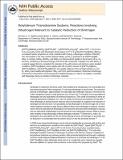Molybdenum Triamidoamine Systems. Reactions Involving Dihydrogen Relevant to Catalytic Reduction of Dinitrogen
Author(s)
Hetterscheid, Dennis G. H.; Hanna, Brian S.; Schrock, Richard Royce
DownloadSchrock_Molybdenum triamidoamine.pdf (933.5Kb)
PUBLISHER_POLICY
Publisher Policy
Article is made available in accordance with the publisher's policy and may be subject to US copyright law. Please refer to the publisher's site for terms of use.
Terms of use
Metadata
Show full item recordAbstract
[HIPTN[subscript 3]N]Mo(N[subscript 2]) (MoN[subscript 2]) ([HIPTN[subscript 3]N][superscript 3−] = [(HIPTNCH2CH2)3N]3− where HIPT = 3,5-(2,4,6-i-Pr[subscript 3]C[subscript 6]H[subscript 2])[subscript 2]C[subscript 6]H[subscript 3]) reacts with dihydrogen slowly (days) at 22 °C to yield [HIPTN[subscript 3]N]MoH[subscript 2] (MoH[subscript 2]), a compound whose properties are most consistent with it being a dihydrogen complex of Mo(III). The intermediate in the slow reaction between MoN[subscript 2] and H[subscript 2] is proposed to be [HIPTN[subscript 3]N]Mo (Mo). In contrast, MoN[subscript 2], MoNH[subscript 3], and MoH[subscript 2] are interconverted rapidly in the presence of H[subscript 2], N[subscript 2], and NH[subscript 3], and MoH[subscript 2] is the lowest energy of the three Mo compounds. Catalytic runs with MoH[subscript 2] as a catalyst suggest that it is competent for reduction of N[subscript 2] with protons and electrons under standard conditions. [HIPTN[subscript 3]N]MoH[subscript 2] reacts rapidly with HD to yield a mixture of [HIPTN[subscript 3]N]MoH[subscript 2], [HIPTN[subscript 3]N]MoD[subscript 2], and [HIPTN[subscript 3]N]MoHD, and rapidly catalyzes H/D exchange between H[subscript 2] and D[subscript 2]. MoH[subscript 2] reacts readily with ethylene, PMe[subscript 3], and CO to yield monoadducts. Reduction of dinitrogen to ammonia in the presence of 32 equiv of added hydrogen (vs Mo) is not catalytic, consistent with dihydrogen being an inhibitor of dinitrogen reduction.
Date issued
2009-07Department
Massachusetts Institute of Technology. Department of ChemistryJournal
Inorganic Chemistry
Publisher
American Chemical Society (ACS)
Citation
Hetterscheid, Dennis G. H., Brian S. Hanna, and Richard R. Schrock. “Molybdenum Triamidoamine Systems. Reactions Involving Dihydrogen Relevant to Catalytic Reduction of Dinitrogen.” Inorganic Chemistry 48, no. 17 (September 7, 2009): 8569-8577.
Version: Author's final manuscript
ISSN
0020-1669
1520-510X